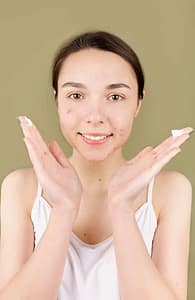Skin Changes During Puberty
Puberty is a significant period in your life when your body experiences various changes, including those affecting your skin. Understanding these changes can help you manage them effectively.
Common Skin Conditions
During puberty, you might notice a variety of skin conditions that weren’t present during your childhood. Acne is one of the most common issues, with breakouts typically occurring in the T-zone — the forehead, nose, and chin — due to increased sebum production in these areas. This excess oil can lead to clogged pores and pimples (KidsHealth).
Apart from acne, you may also experience changes in skin texture and color and an increase in sweat production, particularly in the armpits. Additionally, conditions like dermatitis, which causes inflammation of the skin, and psoriasis, which is characterized by rapid skin cell production leading to scaling, can also manifest or worsen during this time.
Impact of Hormones
Hormones play a pivotal role in the skin changes you experience during puberty. The surge in reproductive hormones—estrogen, progesterone, and testosterone—can lead to increased oil production and clogged pores, resulting in acne breakouts. These breakouts are especially common at the beginning of the menstrual cycle (Dr. Zenovia).
Testosterone, in particular, is responsible for increasing sebum production, as well as armpit sweating and the growth of pubic and axillary hair (DermNet NZ). Additionally, the rise in androgen levels can trigger familial characteristics like congenital melanocytic naevi, which may increase in size and become more pigmented during adolescence.
Understanding these hormonal skin changes can help you navigate and manage the skin care challenges during puberty. For further information on how hormones impact your skin during other life stages, explore our articles on skin changes during pregnancy, skin changes during menopause, and skin changes and stress. Additionally, factors like skin changes and nutrition and skin changes and hydration are also important to consider in your skincare routine.
Specific Skin Issues
During puberty, your body undergoes a series of remarkable changes, and these transformations often manifest in your skin. Understanding these skin issues can help you navigate through this challenging time with confidence and ease.
Acne and Breakouts
Acne is a prevalent skin condition that begins during puberty, affecting a significant number of adolescents and young adults. About 85 percent of people between the ages of 12 and 24 experience at least minor acne. During puberty, hormones, including estrogen, progesterone, and testosterone, surge and stimulate the skin’s oil glands. The excess sebum produced can block pores, leading to pimples, especially in the T-zone—the forehead, nose, and chin (KidsHealth). Hormonal fluctuations around the menstrual cycle further contribute to these breakouts (Dr. Zenovia). To learn more about managing hormonal skin changes, visit our page on hormonal skin changes.
Hair Changes
Hair changes are also a hallmark of puberty. While terminal hair is only present on the scalp, eyelashes, and eyebrows before puberty, it expands to other areas due to androgen activity, most notably testosterone. This results in the development of secondary hair growth in regions such as the underarms and pubic area (DermNet NZ). Additionally, factors such as stress, hormonal imbalances, and certain medications can lead to hair loss or thinning. Patterns of hereditary thinning or baldness can also become evident during this time (American Academy of Dermatology).
Dermatitis and Psoriasis
While less common during puberty than acne, conditions like atopic dermatitis and psoriasis can still occur. Atopic dermatitis, or eczema, can develop at any age but often starts in childhood, with a significant number of cases appearing before the age of 5. It’s a chronic condition that can persist into puberty and adulthood, affecting about 10 percent of the population.
Psoriasis is primarily seen in adults, with the most cases occurring between ages 45 and 64. However, it can start at any age and is characterized by patches of thick, red skin covered with silvery scales. Joint inflammation, leading to psoriatic arthritis, can occur in 25-30 percent of individuals with psoriasis (American Academy of Dermatology). For information on skin changes during other life stages, such as menopause, visit our page on skin changes during menopause.
Navigating skin changes during puberty can be challenging, but understanding your skin’s needs during this transformative phase is the first step towards maintaining its health and appearance. Embrace skincare regimens that address your specific concerns, and don’t hesitate to seek professional advice when needed.
Age-Related Skin Changes
As you journey through different stages of life, your skin undergoes various transformations. While skin changes during puberty are often discussed, it’s essential to address how aging affects skin health, particularly during menopause.
Effects of Aging on Skin
Aging can cause noticeable alterations to your skin’s appearance and texture. The outer skin layer, or the epidermis, may thin even though the layers of cells remain unchanged. Pigment-containing cells known as melanocytes decrease in number, and those that remain grow larger. As a result, aging skin may appear thinner, paler, and more translucent. Additionally, pigmented spots, often called age spots or “liver spots,” may develop in areas frequently exposed to sunlight.
Another significant change is the reduction of connective tissue, which diminishes the skin’s strength and elasticity, a process known as elastosis. This is particularly evident in sun-exposed areas, resulting in a leathery, weather-beaten appearance, especially common among those who spend considerable time outdoors.
Sebaceous glands, which are responsible for oil production, also become less active over time. While men may only notice a slight decrease, usually after age 80, women tend to produce less oil after menopause, leading to drier skin that can be prone to itching (MedlinePlus).
Furthermore, the subcutaneous fat layer that provides insulation and padding diminishes, which not only increases the risk of skin injury but also affects the body’s ability to regulate temperature, potentially leading to a greater risk of hypothermia in colder conditions.
With these changes, it’s not surprising that over 90% of older adults experience some form of skin disorder, many of which can be attributed to prolonged sunlight exposure, a known factor in skin cancers like basal cell cancer, squamous cell carcinoma, and melanoma.
Skin Health in Menopause
Menopause marks a significant shift in a woman’s life, and the skin is no exception to the changes brought on by this transition. As estrogen levels decline, you may notice your skin becoming dryer, less elastic, and more susceptible to wrinkles. It’s not uncommon for skin conditions to emerge or worsen during this time, including skin thinning, dryness, and changes in pigmentation.
To manage these changes and maintain skin health, consider the following:
- Hydration: Ensuring adequate water intake is crucial for maintaining skin hydration from the inside out. Learn more about skin changes and hydration.
- Nutrition: A balanced diet rich in antioxidants and essential nutrients can support skin health. Explore the link between skin changes and nutrition.
- Sun Protection: Protecting your skin from harmful UV rays is vital in preventing further damage and reducing the risk of skin cancer.
- Gentle Skincare: Adopting a gentle skincare routine that addresses dryness and sensitivity can help manage the skin changes associated with menopause.
By understanding these age-related skin changes and adapting your skincare routine accordingly, you can better navigate the transformations your skin undergoes during menopause. For further guidance on managing hormonal skin changes, including those occurring during perimenopause, visit skin changes during menopause. Additionally, it’s essential to be aware of how life events such as skin changes during pregnancy, skin changes after childbirth, skin changes during menstruation, and skin changes and stress can affect your skin’s health.
Skincare Tips
Embarking on a journey to navigate through skin changes during puberty can be daunting. As your body experiences a transformation, your skin care needs also evolve. Below are some essential tips to help you establish an effective skincare regimen and manage hormonal acne.
Skincare Regimen
When developing a skincare routine during this transformative time, it’s important to focus on products that address the unique challenges that puberty presents. Hormonal fluctuations can lead to increased oiliness and breakouts, so incorporating specific products can be beneficial.
- Cleansing: Start with a gentle cleanser to wash away excess oil and impurities. This should be done twice daily, in the morning and at night.
- Acne Spot Treatments: Integrate acne spot treatments containing Benzoyl Peroxide, which helps to combat bacteria, or Bakuchiol, a natural alternative to retinol, known for its anti-inflammatory properties. Aloe Vera is also recommended for its soothing effects on the skin. These can be applied directly to blemishes as needed. (Dr. Zenovia)
- Exfoliation: Incorporate exfoliants with Glycolic Acid or Salicylic Acid to help shed dead skin cells and keep pores clear. Begin with a lower concentration to assess skin tolerance and use once or twice a week.
- Moisturizing: Hydrate your skin with a non-comedogenic moisturizer to maintain its natural barrier without clogging pores.
- Sun Protection: Apply broad-spectrum sunscreen daily to protect your skin from harmful UV rays, which can aggravate acne and lead to premature aging.
Remember to introduce new products gradually and decrease frequency if you experience dryness or irritation. It’s also crucial to stay consistent with your regimen to see improvements.
Hormonal Acne Management
Managing hormonal acne requires a dual approach: topical treatments and understanding the hormonal triggers.
- Recognize Hormonal Fluctuations: Be mindful that acne breakouts are often more prevalent at the beginning of the menstrual cycle due to a surge in hormones like estrogen, progesterone, and testosterone. These hormones can increase oil production and lead to clogged pores. (Dr. Zenovia)
- Topical Treatments: Consider using products formulated with the REG-ulate360 Complex™, a proprietary blend of phytoestrogens that can help balance hormones affecting the skin, thus reducing acne flares. (Dr. Zenovia)
- Lifestyle Adjustments: Address skin changes and stress by engaging in stress-reducing activities, as stress can exacerbate acne. Also, maintain a balanced diet (skin changes and nutrition) and stay hydrated (skin changes and hydration) to support overall skin health.
- Professional Guidance: If over-the-counter products are not effective, seek advice from a dermatologist, who may recommend prescription treatments or hormonal therapy.
By implementing these skincare tips, you can take proactive steps in managing the skin changes during this pivotal stage of life. As you adapt to these changes, remember to be patient with your skin and yourself. For more in-depth information on how skin changes throughout different life stages, explore topics such as skin changes during menopause, skin changes during perimenopause, and skin changes after childbirth.


